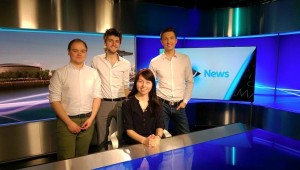 Dr Galina Motorina (Researcher from Pulkovo Observatory, Russia) will be visiting us for three weeks.
Dr Galina Motorina (Researcher from Pulkovo Observatory, Russia) will be visiting us for three weeks.
Her work is on the diagnostics of energy release in the solar corona using X-ray and EUV emissions (Support by the RSF grant No.16-12-10448).
 Dr Galina Motorina (Researcher from Pulkovo Observatory, Russia) will be visiting us for three weeks.
Dr Galina Motorina (Researcher from Pulkovo Observatory, Russia) will be visiting us for three weeks.
Her work is on the diagnostics of energy release in the solar corona using X-ray and EUV emissions (Support by the RSF grant No.16-12-10448).
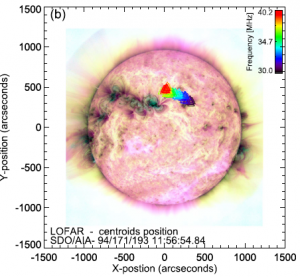
The triangle symbols indicate the centroids of the fundamental LOFAR source at the frequencies. The background image is SDO/AIA taken from Chen et al, ApJ 2018
Xingyao Chen (National Astronomical Observatories Chinese Academy of Sciences, Beijing) will be visiting us as a PhD scholar for 12 months.
She will be work with the solar radio data from LOFAR and to study the energetic particles responsible for the solar radio emission in solar flares.
Her recent paper on Fine Structures of Solar Radio Type III Bursts has just been published in the Astrophysical Journal in March 2018: http://adsabs.harvard.edu/abs/2018ApJ…856…73C
Ben Alcock with thesis entitled “Solar Electron and Radio Wave Propagation in the Turbulent Solar Corona” successfully passed his viva on Thursday March 22.
A part part of the thesis was published and another part is in preparation for publication.
The mini-volume published in RAA journal presented research papers based on talks at the 1st RadioSun workshop in China. The RadioSun network links research teams from China, Czech Republic, Poland, Russia and the UK. The paper by Hamish Reid and Heather Ratcliffe won a RAA Excellent Paper award.
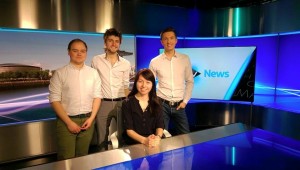
Some of the Glasgow solar PhD students (Paul Wright, Stephen Brown, Galina Motorina) broadcasting live with STV’s Sean Batty during the eclipse
Galina Motorina was awarded a PhD degree for her work entitled “Dynamics of plasma heating and energy distributions of accelerated electrons during solar flares based on X-ray and ultraviolet emission“. Galina was a visiting PhD student in Astronomy & Astrophysics group for a number of months and worked on thermal properties of solar flares and differential emission measure reconstruction from RHESSI and SDO observations.
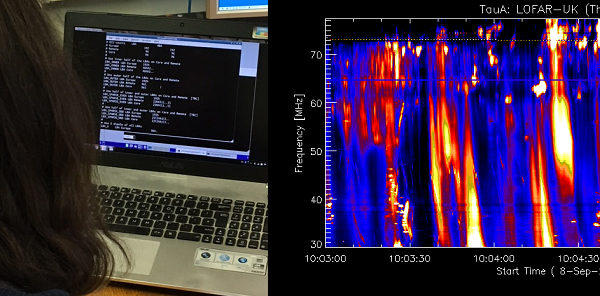
Right: Nicolina operates The Rawlings Array (UK LOFAR), Left: Observations of the solar radio bursts in sidelobes while pointing array to TauA.
Nicolina Chrysaphi have successfully captured a number of solar radio bursts using the Rawling Array (aka UK-LOFAR). The preliminary quick-look images show the variety of fascinating solar phenomena.
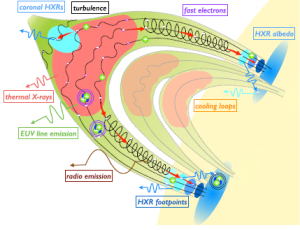
Cartoon created by Dr Jeffrey
In the PhysicsCentral article, “Small-Scale Turbulence May Help Power Solar Explosions” the complex physics about role of turbulence in solar flares is explained using simple terms. The Glasgow-led research team spread over 13 time zones represents six languages, five solar instruments, and various areas of expertise on the Sun’s activity.
With PhysicsCentral, the American Physical Society communicates the excitement and importance of physics to everyone.
Graham Kerr with thesis “Observations and Modelling of the Chromosphere During Solar Flares” and Duncan Stackhouse with thesis “The Acceleration and Transport of Electron Populations in Solar Flares” successfully passed their vivas.
Alliance Meeting on energetic particles in solar flares [webpage] , contact Nic Bian regarding the meeting.
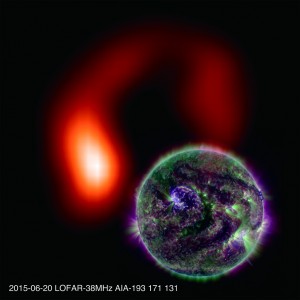
Coronal Mass Ejection and radio source imaged by LOFAR and SDO (see details here)
A fully funded PhD studentship is available in the area of Solar Radio Physics at the University of Glasgow. It is a joint UK-Franco project supported by Direction Générale de l’Armement (DGA) and Defence Science and Technology Laboratory (Dstl). The successful candidate will be based in Glasgow in the Astronomy & Astrophysics group (http://www.astro.gla.ac.uk) and they will closely collaborate with Paris Observatory, Meudon. The PhD student will work with imaging and spectroscopic data from the Low Frequency Array (LOFAR), developing simulations to establish more detailed links between radio transient phenomena and the fine structures in radio burst spectra.
The student should have a minimum of a 2.1 honours degree or higher in a relevant discipline and should be a UK or French National. The anticipated start date is 1st October 2016. Interested candidates should email Dr Kontar.
 In the outer solar corona, the radio observations provide the unique link between near-Sun phenomena and the effects of solar activity that extend throughout the heliosphere. ‘RadioSun‘ sponsored researchers use Low Frequency Array (LOFAR) radio images to study giant radio source associated with a Coronal Mass Ejection.
In the outer solar corona, the radio observations provide the unique link between near-Sun phenomena and the effects of solar activity that extend throughout the heliosphere. ‘RadioSun‘ sponsored researchers use Low Frequency Array (LOFAR) radio images to study giant radio source associated with a Coronal Mass Ejection.
“In recognition of truly outstanding research achievements associated with PhD study in the broad field of plasma physics”, the Plasma Physics Division of the European Physical Society (EPS) awarded Dr Natasha Jeffrey a PhD prize for her thesis “The spatial, spectral and polarization properties of solar flare X-ray sources“
Glasgow solar physicist Dr Bian presents a general public talk for 12+ about the Sun in Irkutsk. “Rendezvous with the sun”
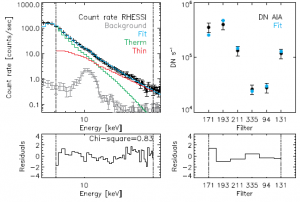 Galina Motorina, former visiting PhD student in A&A group has won a prestigious prize from the Government of St Petersburg for her work on RHESSI and SDO/AIA data [announcement translated by Google]. This work on DEM in flares has been partially published Geomagnetism and Aeronomy and The Astrophysical Journal.
Galina Motorina, former visiting PhD student in A&A group has won a prestigious prize from the Government of St Petersburg for her work on RHESSI and SDO/AIA data [announcement translated by Google]. This work on DEM in flares has been partially published Geomagnetism and Aeronomy and The Astrophysical Journal.
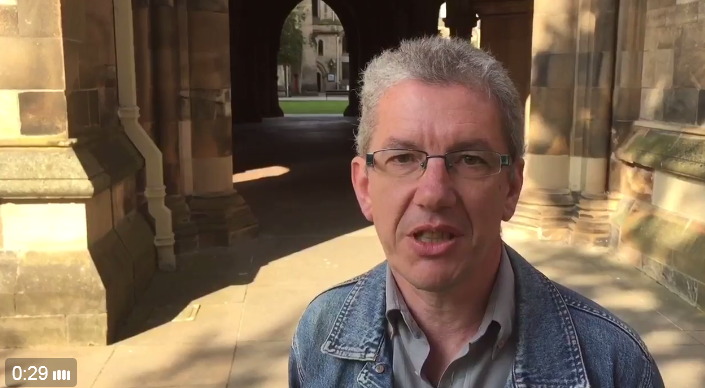 In a short video, Alec explains the importance of solar system plasmas to be discussed at STFC Introductory Solar System Plasmas School hosted by Astronomy & Astrophysics group
In a short video, Alec explains the importance of solar system plasmas to be discussed at STFC Introductory Solar System Plasmas School hosted by Astronomy & Astrophysics group
The School’s objective is to bring internationally leading UK scientists to instruct and inspire the incoming PhD students. It will provide them with the broad context in which their specific research will reside, and encourage interdisciplinary thinking from the outset.

Thanks to Paul Wright and Duncan Stackhouse one can follow CESRA school via twitter #CESRA2015
Hamish Reid and Natasha Jeffrey speak about radio school in a short UoG video

Glasgow University is hosting the 2015 CESRA radio summer school. The school is open to solar radio physicists including PhD students and early career researchers. The school will cover the essential elements of theory, modelling and data analysis and will feature lectures and tutorials. Students will have the opportunity to meet and discuss research topics with their peers together in an informal atmosphere.
Further details: http://www.astro.gla.ac.uk/cesra2015/
Baolin Tan (China), Alexey Kuznetsov (Irkutsk, Russia) and Sergei Kuznetsov and Alexander Morgachev (Pulkovo, Russia) visit our group to work on the solar flares and radio emission from the Sun. The visits are supported by pan-European EU funded network ‘RadioSun’ involving China, Czech Republic, Poland, Russia and the UK.
Dr Prasad Subramanian, an associate professor of Physics at IISER Pune, visited the Glasgow Astronomy Group to study eruptions on the Sun. The collaboration is associated with the renewal of an agreement between University of Glasgow and Indian Institute of Science Education and Research in Pune (IISER-Pune).
Duncan Stackhouse, Nic Bian, Iain Hannah and Eduard Kontar jointed solar flare experts from around the world gathered at NJIT last week to share the latest research with RHESSI at 14th RHESSI workshop.
Duncan Stackhouse presented the best talk (about simulation of ‘kappa’ distribution and Numerical and Observational Examination of the Spectral Variation of Extended Coronal Hard X-Ray Sources of kappa-distribution) among 3rd year Ph.D. students of the school at the colloquium session (Wed May 6th, 2015).
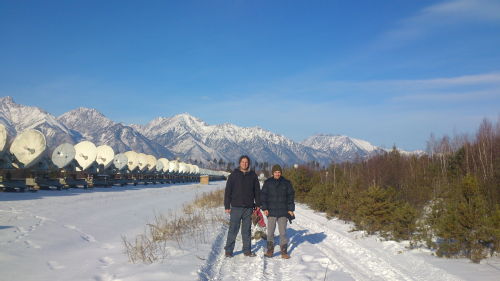
Dr Nic Bian (Glasgow) and a colleague from the Institute of Solar-Terrestrial Physics, Irkutsk at the Siberian Solar Radio Telescope.